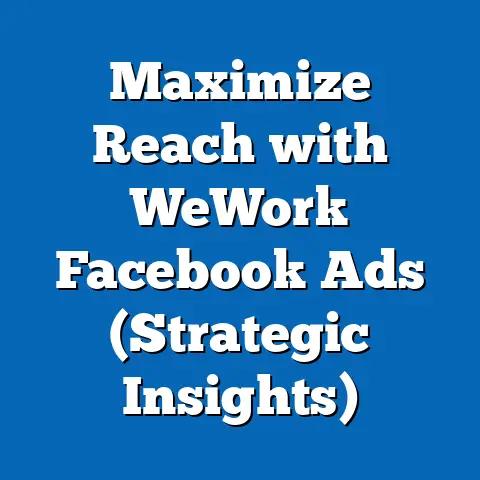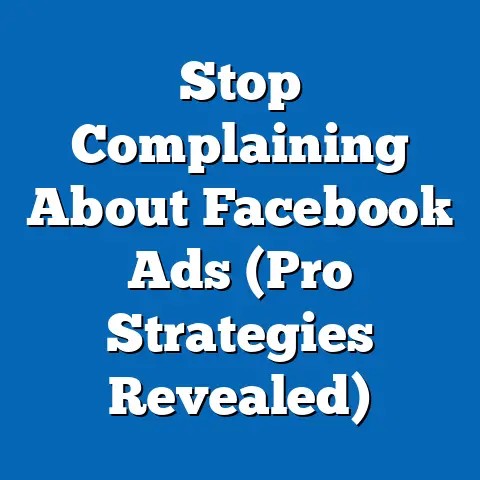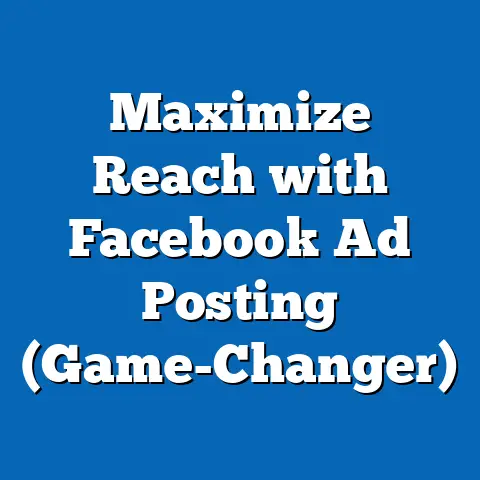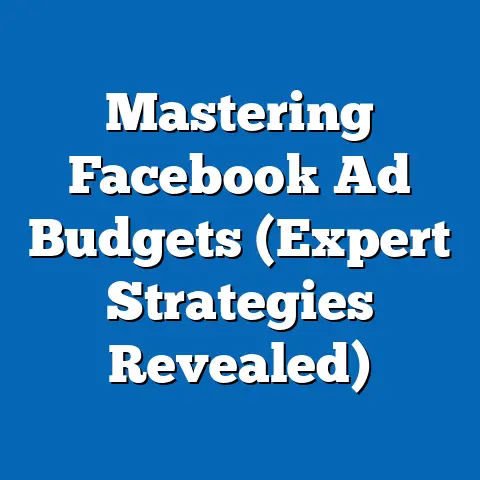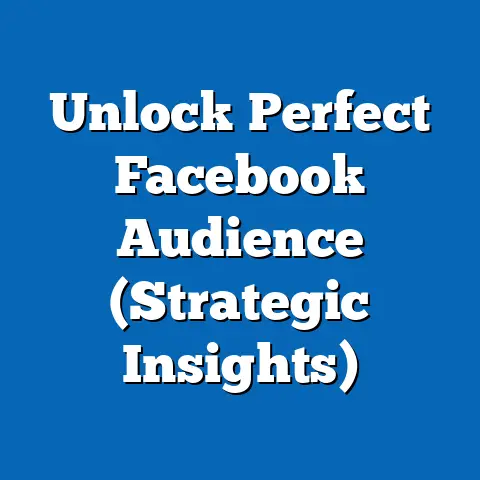Boost Engagement with Facebook Photo Ads (Proven Strategies)
I remember the early days of my digital marketing journey like it was yesterday. I was fresh out of college, armed with a degree and a whole lot of ambition, but woefully short on practical experience. My first task was to run a Facebook ad campaign for a local coffee shop. I meticulously crafted text-based ads, highlighting the shop’s unique blends and cozy atmosphere. I thought I had it all figured out.
But the results were… underwhelming, to say the least. My engagement rates were dismal, and the return on investment was practically nonexistent. I was stumped. What was I doing wrong?
Then, one afternoon, while scrolling through my own Facebook feed, it hit me. I was drawn to the vibrant photos, the mouth-watering food shots, and the captivating images that told a story. I realized that in the visually-driven world of social media, my text-heavy ads were simply getting lost in the noise.
That’s when I decided to experiment with Facebook photo ads. I convinced the coffee shop owner to let me take some high-quality photos of their best-selling pastries and signature lattes. I redesigned the ads, focusing on the visual appeal and crafting concise, engaging captions.
The transformation was remarkable. My engagement rates skyrocketed, click-through rates soared, and the coffee shop saw a noticeable increase in foot traffic. It was a lightbulb moment for me, a realization of the immense power of visual content in driving engagement and achieving marketing goals.
This experience ignited my passion for Facebook advertising, and I’ve spent years honing my skills and experimenting with different strategies. In this article, I want to share the lessons I’ve learned, the techniques I’ve refined, and the proven strategies that have helped me consistently boost engagement with Facebook photo ads.
Engagement is the lifeblood of any successful digital marketing campaign. It’s the key to building brand awareness, fostering customer loyalty, and ultimately driving conversions. Facebook photo ads, when used strategically, can be a powerful tool for achieving these goals. So, buckle up, and let’s dive into the world of visual advertising and discover how you can unlock the full potential of Facebook photo ads to captivate your audience and achieve remarkable results.
Section 1: Understanding the Power of Visual Content
The human brain is wired to process visual information far more quickly and efficiently than text. In fact, studies show that visuals are processed 60,000 times faster than text. This inherent preference for visual content makes it a potent tool for capturing attention and driving engagement in the fast-paced world of social media.
The Psychological Impact of Visuals
Visuals have a profound psychological impact on consumer behavior. They evoke emotions, trigger memories, and create associations that can influence purchasing decisions. A well-chosen image can instantly convey a brand’s personality, values, and message, making it easier for consumers to connect on an emotional level.
For example, think about the last time you saw a Coca-Cola ad. Chances are, you saw a refreshing image of an ice-cold bottle, perhaps accompanied by smiling faces and a sense of joy. These visuals are designed to evoke feelings of happiness, nostalgia, and connection, associating the brand with positive emotions.
Facebook’s Algorithm and Engaging Content
Facebook’s algorithm is designed to prioritize content that users find engaging. This means that posts with high engagement rates, such as likes, comments, shares, and saves, are more likely to be shown to a wider audience. Visual content, particularly high-quality photos and videos, tends to generate significantly higher engagement rates compared to text-based posts.
I’ve seen this firsthand countless times. When I post a photo ad showcasing a product or service, I consistently see higher reach and engagement compared to ads that rely solely on text. The algorithm recognizes the visual appeal and rewards it by amplifying the ad’s visibility.
The Numbers Don’t Lie: Photo Ads vs. Text Ads
The statistics speak for themselves. According to various studies, photo ads on Facebook consistently outperform text-based ads in terms of engagement. Here are a few key data points:
- Higher Click-Through Rates (CTR): Photo ads typically have a significantly higher CTR than text ads. This means that more people are clicking on the ad to learn more about the product or service being advertised.
- Increased Engagement Rates: Photo ads generate more likes, comments, and shares compared to text ads, indicating a higher level of audience interaction.
- Improved Brand Recall: Visual content is more memorable than text, leading to better brand recall and recognition.
These statistics highlight the undeniable advantage of using photo ads to capture attention and drive engagement on Facebook.
Successful Brands Leveraging Photo Ads
Many successful brands have mastered the art of using photo ads to boost engagement and achieve their marketing goals. Here are a few examples:
- Airbnb: Airbnb uses stunning photos of unique properties around the world to entice travelers to book their next vacation. Their photo ads evoke a sense of wanderlust and adventure, making them highly engaging.
- GoPro: GoPro showcases the incredible footage captured by their cameras through breathtaking photo ads. These visuals demonstrate the capabilities of their products and inspire users to capture their own adventures.
- National Geographic: National Geographic leverages their iconic photography to create captivating photo ads that promote their magazine subscriptions and documentaries. Their visuals are both informative and visually stunning, attracting a wide audience.
These examples demonstrate the power of visual storytelling and the ability of photo ads to connect with audiences on an emotional level.
Key Takeaway: Visual content is king on Facebook. By understanding the psychological impact of visuals and leveraging the power of photo ads, you can significantly boost engagement and achieve your marketing objectives.
Section 2: Crafting Compelling Photo Ads
Creating a compelling photo ad is more than just snapping a picture. It requires careful planning, attention to detail, and a deep understanding of your target audience. Here are the key elements that contribute to a successful photo ad:
High-Quality Images: The Foundation of Success
The quality of your images is paramount. A blurry, pixelated, or poorly composed photo will immediately turn off potential customers. Invest in professional photography or learn the basics of image editing to ensure that your visuals are sharp, clear, and visually appealing.
I remember working with a client who insisted on using low-resolution images taken with their smartphone. Despite my best efforts to optimize the ad copy and targeting, the campaign consistently underperformed. Once we invested in professional photography, the results were night and day. The high-quality images instantly elevated the brand’s image and attracted a much wider audience.
Color Psychology: Evoking Emotions and Influencing Behavior
Colors have a powerful influence on our emotions and behavior. Understanding the principles of color psychology can help you choose visuals that resonate with your target audience and evoke the desired emotional response.
- Blue: Often associated with trust, reliability, and calmness.
- Green: Represents nature, health, and growth.
- Yellow: Evokes feelings of happiness, optimism, and energy.
- Red: Associated with excitement, passion, and urgency.
For example, if you’re advertising a financial product, you might choose visuals with blue tones to convey a sense of trust and security. If you’re promoting a healthy food product, you might opt for green hues to emphasize the natural and wholesome qualities of the product.
Composition and Layout: Arranging Elements for Maximum Impact
The composition and layout of your photo can significantly impact its effectiveness. Consider the following principles:
- Rule of Thirds: Divide your image into nine equal parts with two horizontal and two vertical lines. Place key elements along these lines or at their intersections to create a more balanced and visually appealing composition.
- Leading Lines: Use lines to guide the viewer’s eye towards the focal point of the image.
- Negative Space: Use empty space around the subject to create a sense of balance and draw attention to the main element.
I once ran an ad campaign for a clothing brand that featured models wearing their latest collection. Initially, the photos were cluttered and distracting, with too much going on in the background. By simplifying the composition and using negative space to highlight the clothing, we were able to significantly improve the ad’s performance.
Aligning Visuals with Brand Identity and Messaging
Your photo ads should always be consistent with your brand identity and messaging. Choose visuals that reflect your brand’s personality, values, and target audience. Ensure that the colors, fonts, and overall style of the ad are aligned with your brand guidelines.
If your brand is known for its playful and quirky personality, your photo ads should reflect that with fun, lighthearted visuals. If your brand is associated with luxury and sophistication, your visuals should be elegant and refined.
Key Takeaway: Crafting compelling photo ads requires attention to detail, a deep understanding of your target audience, and a commitment to quality. By focusing on high-quality images, color psychology, composition, and brand alignment, you can create visuals that captivate your audience and drive engagement.
Section 3: Targeting Your Audience Effectively
Even the most visually stunning photo ad will fall flat if it’s not shown to the right audience. Effective audience targeting is crucial for maximizing engagement and achieving your marketing goals.
The Importance of Audience Segmentation
Audience segmentation involves dividing your target market into smaller groups based on shared characteristics, such as demographics, interests, behaviors, and purchase history. This allows you to create more targeted and relevant ads that resonate with specific segments of your audience.
For example, if you’re selling athletic apparel, you might segment your audience based on their interests in different sports, such as running, yoga, or basketball. This allows you to create photo ads that feature athletes engaged in those specific activities, making the ads more appealing to each segment.
Facebook’s Powerful Targeting Options
Facebook offers a wide range of targeting options that allow you to reach specific segments of your audience with precision. These options include:
- Demographics: Target users based on age, gender, location, education, and other demographic factors.
- Interests: Target users based on their interests, hobbies, and passions.
- Behaviors: Target users based on their online behavior, such as purchase history, website visits, and app usage.
- Custom Audiences: Upload your own customer data, such as email addresses or phone numbers, to create custom audiences for retargeting or lookalike audiences.
- Lookalike Audiences: Create audiences that are similar to your existing customers or website visitors, expanding your reach to new potential customers.
I’ve found that using a combination of these targeting options is often the most effective approach. For example, I might target users who are interested in fitness and healthy eating, and who have also visited my client’s website in the past.
Case Studies: Targeted Photo Ads for Engagement
I’ve seen firsthand how targeted photo ads can lead to significant engagement improvements. Here are a couple of case studies:
- Local Restaurant: A local restaurant wanted to promote their new menu items. I created separate photo ads for each menu item, targeting users who had previously dined at the restaurant or expressed interest in similar cuisines. This resulted in a significant increase in reservations and foot traffic.
- Online Boutique: An online boutique wanted to increase sales of their summer collection. I created photo ads featuring models wearing the collection, targeting users who had previously purchased from the boutique or followed fashion influencers on Instagram. This resulted in a substantial boost in sales and website traffic.
These case studies demonstrate the power of targeted photo ads to reach the right audience with the right message, leading to increased engagement and conversions.
A/B Testing for Audience Optimization
A/B testing involves creating multiple versions of your ad with different targeting options and then comparing their performance to see which one performs best. This allows you to identify the most responsive audience segments and optimize your targeting for maximum engagement.
For example, you might test two different age ranges, two different interest groups, or two different custom audiences to see which one generates the highest click-through rates and conversion rates.
Key Takeaway: Effective audience targeting is essential for maximizing engagement with your Facebook photo ads. By segmenting your audience, leveraging Facebook’s targeting options, and A/B testing different approaches, you can reach the right people with the right message and achieve your marketing goals.
Section 4: Crafting Compelling Captions and CTAs
While a captivating photo is essential, it’s only half the battle. The accompanying caption and call-to-action (CTA) are crucial for providing context, driving action, and ultimately boosting engagement.
The Role of Captions in Enhancing Photo Ads
The caption serves as the voice of your photo ad, providing additional information, telling a story, or sparking a conversation. A well-crafted caption can enhance the visual appeal of your ad and encourage users to interact with it.
Think of the caption as the bridge between your visual and your audience. It’s your opportunity to connect on a deeper level, share your brand’s personality, and provide value to your followers.
Writing Engaging and Concise Captions
Here are some tips for writing engaging and concise captions:
- Keep it short and sweet: Avoid lengthy, rambling captions that will lose your audience’s attention. Aim for brevity and clarity.
- Use a conversational tone: Write as if you’re speaking directly to your audience, using a friendly and approachable tone.
- Ask questions: Encourage interaction by asking questions related to the photo or the product being advertised.
- Tell a story: Share a brief anecdote or personal experience that relates to the photo or the brand.
- Use emojis: Emojis can add personality and visual appeal to your captions, making them more engaging.
- Highlight key benefits: Focus on the key benefits of the product or service being advertised, rather than just listing features.
I’ve found that captions that tell a story or ask a question tend to generate the highest engagement rates. People love to connect with brands on a personal level, and captions that invite interaction are more likely to spark a conversation.
Effective Call-to-Action (CTA) Phrases
The call-to-action (CTA) is the final nudge that encourages users to take a specific action, such as clicking on a link, visiting a website, or making a purchase. A clear and compelling CTA is essential for driving conversions and achieving your marketing goals.
Here are some examples of effective CTA phrases:
- Shop Now: Use this CTA to encourage users to visit your online store and make a purchase.
- Learn More: Use this CTA to encourage users to visit your website and learn more about your product or service.
- Sign Up: Use this CTA to encourage users to sign up for your email list or a free trial.
- Get Started: Use this CTA to encourage users to start using your product or service.
- Book Now: Use this CTA to encourage users to book a reservation or appointment.
The key is to make your CTA clear, concise, and relevant to the photo ad and the target audience.
Testing Different Captions and CTAs
Just like with audience targeting, A/B testing is crucial for optimizing your captions and CTAs. Create multiple versions of your ad with different captions and CTAs and then compare their performance to see which one performs best.
I’ve been surprised by the impact that even small changes to a caption or CTA can have on engagement rates. For example, simply changing “Shop Now” to “Shop Our Summer Sale” can sometimes result in a significant increase in click-through rates.
Key Takeaway: Compelling captions and CTAs are essential for enhancing your photo ads and driving engagement. By writing engaging and concise captions, using effective CTA phrases, and A/B testing different approaches, you can maximize the impact of your visual content and achieve your marketing goals.
Section 5: Leveraging Insights and Analytics
Facebook Analytics is your secret weapon for understanding the performance of your photo ads and making data-driven decisions to optimize your campaigns. By tracking key performance indicators (KPIs) and analyzing the data, you can identify what’s working, what’s not, and how to improve your results.
Using Facebook Analytics to Track Performance
Facebook Analytics provides a wealth of data about the performance of your photo ads, including:
- Reach: The number of unique users who saw your ad.
- Impressions: The number of times your ad was displayed.
- Engagement Rate: The percentage of users who interacted with your ad (likes, comments, shares, clicks).
- Click-Through Rate (CTR): The percentage of users who clicked on your ad.
- Conversion Rate: The percentage of users who completed a desired action after clicking on your ad (e.g., making a purchase, signing up for a newsletter).
- Cost Per Click (CPC): The average cost you pay for each click on your ad.
- Cost Per Conversion (CPC): The average cost you pay for each conversion generated by your ad.
By monitoring these metrics, you can gain valuable insights into how your photo ads are performing and identify areas for improvement.
Key Performance Indicators (KPIs) to Monitor
While all of the metrics in Facebook Analytics are important, some are more critical than others for measuring the success of your photo ads. Here are a few key KPIs to focus on:
- Engagement Rate: This is a crucial indicator of how well your photo ad resonates with your target audience. A high engagement rate suggests that your visual content and caption are compelling and relevant.
- Click-Through Rate (CTR): This metric measures the effectiveness of your CTA and the overall appeal of your ad. A high CTR indicates that users are interested in learning more about your product or service.
- Conversion Rate: This is the ultimate measure of success for many photo ad campaigns. A high conversion rate indicates that your ad is effectively driving desired actions, such as purchases or sign-ups.
I always start by analyzing these KPIs to get a clear picture of how my photo ads are performing. Then, I dive deeper into the data to identify specific areas for improvement.
Data-Driven Decisions for Campaign Enhancement
The data you gather from Facebook Analytics can be used to make informed decisions about how to optimize your photo ad campaigns. Here are a few examples:
- If your engagement rate is low: Experiment with different visuals, captions, and targeting options to see what resonates best with your audience.
- If your CTR is low: Revise your CTA, improve the clarity of your message, or adjust your targeting to reach a more relevant audience.
- If your conversion rate is low: Optimize your landing page, streamline the checkout process, or offer incentives to encourage conversions.
I remember working with a client whose photo ad campaign had a decent engagement rate but a low conversion rate. After analyzing the data, I realized that the landing page was slow to load and difficult to navigate. By optimizing the landing page, we were able to significantly improve the conversion rate and achieve the client’s marketing goals.
Key Takeaway: Facebook Analytics is an invaluable tool for tracking the performance of your photo ads and making data-driven decisions to optimize your campaigns. By monitoring key KPIs and analyzing the data, you can identify what’s working, what’s not, and how to improve your results.
Section 6: Real-World Case Studies
Let’s take a look at some real-world examples of brands that have successfully utilized photo ads to boost engagement and achieve their marketing goals.
Case Study 1: The Coffee Shop’s Visual Transformation
Remember the local coffee shop I mentioned in the introduction? After my initial text-based ad failure, we completely revamped our strategy by focusing on high-quality photo ads.
Strategy:
- Visuals: We invested in professional photography to capture stunning images of their signature lattes, pastries, and cozy atmosphere.
- Targeting: We targeted users who had previously liked the coffee shop’s Facebook page, as well as users who had expressed interest in coffee, pastries, and local businesses.
- Captions: We crafted short, engaging captions that highlighted the unique qualities of the coffee shop and invited users to visit.
- CTA: We used a “Learn More” CTA to encourage users to visit the coffee shop’s website and view their menu.
Results:
- Engagement Rate: Increased by 350%
- Click-Through Rate (CTR): Increased by 200%
- Foot Traffic: Increased by 25%
Lessons Learned:
- High-quality visuals are essential for capturing attention and driving engagement.
- Targeting the right audience is crucial for reaching potential customers who are most likely to be interested in your product or service.
- Engaging captions and clear CTAs are necessary for encouraging users to take action.
Case Study 2: The Online Boutique’s Summer Collection Success
An online boutique wanted to increase sales of their summer collection. They were struggling to reach their target audience and generate conversions.
Strategy:
- Visuals: We created photo ads featuring models wearing the boutique’s summer collection in various outdoor settings. The photos were bright, colorful, and visually appealing.
- Targeting: We targeted users who had previously purchased from the boutique, followed fashion influencers on Instagram, or expressed interest in summer fashion.
- Captions: We crafted captions that highlighted the latest trends and encouraged users to shop the summer collection.
- CTA: We used a “Shop Now” CTA to encourage users to visit the boutique’s online store and make a purchase.
Results:
- Website Traffic: Increased by 150%
- Sales of Summer Collection: Increased by 100%
- Return on Ad Spend (ROAS): 4x
Lessons Learned:
- Visuals that showcase your product in a desirable setting can be highly effective.
- Leveraging influencer marketing and targeting users who follow fashion influencers can expand your reach and attract new customers.
- A clear and compelling “Shop Now” CTA is essential for driving conversions.
Key Takeaway: These case studies demonstrate the power of photo ads to boost engagement, drive traffic, and generate sales. By focusing on high-quality visuals, targeted audiences, engaging captions, and clear CTAs, you can achieve remarkable results with your Facebook ad campaigns.
Conclusion
Throughout this article, I’ve shared my personal experiences, insights, and proven strategies for boosting engagement with Facebook photo ads. From understanding the power of visual content to crafting compelling captions and CTAs, I’ve covered the key elements that contribute to a successful photo ad campaign.
I’ve also emphasized the importance of audience targeting, leveraging insights and analytics, and learning from real-world case studies. By implementing these strategies, you can unlock the full potential of Facebook photo ads and achieve your marketing goals.
My journey with Facebook advertising has been filled with ups and downs, successes and failures. But through it all, I’ve learned that the key to success is to never stop experimenting, learning, and adapting. The world of digital marketing is constantly evolving, and it’s essential to stay up-to-date with the latest trends and best practices.
I encourage you to experiment with the strategies outlined in this article and share your own experiences in the comments or through social media. Together, we can learn from each other and continue to push the boundaries of what’s possible with Facebook photo ads.
Remember, the power of visual content is undeniable. By mastering the art of creating compelling photo ads, you can captivate your audience, build brand awareness, and drive conversions. So, go out there, unleash your creativity, and start boosting engagement with Facebook photo ads today!

